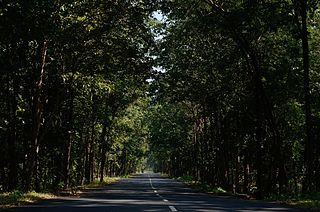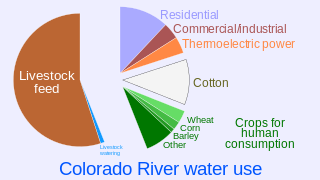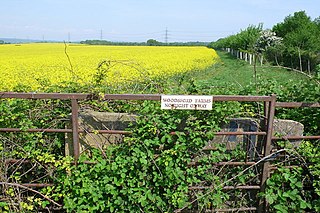Public property is property that is dedicated to public use. The term may be used either to describe the use to which the property is put, or to describe the character of its ownership. This is in contrast to private property, owned by an individual person or artificial entities that represent the financial interests of persons, such as corporations. State ownership, also called public ownership, government ownership or state property, are property interests that are vested in the state, rather than an individual or communities.
In all modern states, a portion of land is held by central or local governments. This is called public land, state land, or Crown land. The system of tenure of public land, and the terminology used, varies between countries. The following examples illustrate some of the range.

The freedom to roam, or "everyman's right", is the general public's right to access certain public or privately owned land, lakes, and rivers for recreation and exercise. The right is sometimes called the right of public access to the wilderness or the "right to roam".
Land trusts are nonprofit organizations which own and manage land, and sometimes waters. There are three common types of land trust, distinguished from one another by the ways in which they are legally structured and by the purposes for which they are organized and operated:


In common law systems, land tenure, from the French verb "tenir" means "to hold", is the legal regime in which land owned by an individual is possessed by someone else who is said to "hold" the land, based on an agreement between both individuals. It determines who can use land, for how long and under what conditions. Tenure may be based both on official laws and policies, and on informal local customs. In other words, land tenure implies a system according to which land is held by an individual or the actual tiller of the land but this person does not have legal ownership. It determines the holder's rights and responsibilities in connection with their holding. The sovereign monarch, known in England as The Crown, held land in its own right. All land holders are either its tenants or sub-tenants. Tenure signifies a legal relationship between tenant and lord, arranging the duties and rights of tenant and lord in relationship to the land. Over history, many different forms of land tenure, i.e., ways of holding land, have been established.
Riparian water rights is a system for allocating water among those who possess land along its path. It has its origins in English common law. Riparian water rights exist in many jurisdictions with a common law heritage, such as Canada, Australia, New Zealand, and states in the eastern United States.
Water right in water law is the right of a user to use water from a water source, e.g., a river, stream, pond or source of groundwater. In areas with plentiful water and few users, such systems are generally not complicated or contentious. In other areas, especially arid areas where irrigation is practiced, such systems are often the source of conflict, both legal and physical. Some systems treat surface water and ground water in the same manner, while others use different principles for each.
Hawaii Housing Authority v. Midkiff, 467 U.S. 229 (1984), was a case in which the United States Supreme Court held that a state could use eminent domain to take land that was overwhelmingly concentrated in the hands of private landowners and redistribute it to the wider population of private residents.

Forestry laws govern activities in designated forest lands, most commonly with respect to forest management and timber harvesting. Forestry laws generally adopt management policies for public forest resources, such as multiple use and sustained yield. Forest management is split between private and public management, with public forests being sovereign property of the State. Forestry laws are now considered an international affair.

The public trust doctrine is the principle that the sovereign holds in trust for public use some resources such as shoreline between the high and low tide lines, regardless of private property ownership.

Social forestry is the management and protection of forests and afforestation of barren and deforested lands with the purpose of helping environmental, social and rural development. The term social forestry was first used in 1976 by The National Commission on Agriculture, when the government of India aimed to reduce pressure on forests by planting trees on all unused and fallow lands. It was intended as a democratic approach to forest conservation and usage, maximizing land utilization for multiple purposes.
Oil and gas law in the United States is the branch of law that pertains to the acquisition and ownership rights in oil and gas both under the soil before discovery and after its capture, and adjudication regarding those rights.

The Washington State Department of Natural Resources (DNR) manages over 3,000,000 acres (12,000 km2) of forest, range, agricultural, and commercial lands in the U.S. state of Washington. The DNR also manages 2,600,000 acres (11,000 km2) of aquatic areas which include shorelines, tidelands, lands under Puget Sound and the coast, and navigable lakes and rivers. Part of the DNR's management responsibility includes monitoring of mining cleanup, environmental restoration, providing scientific information about earthquakes, landslides, and ecologically sensitive areas. DNR also works towards conservation, in the form of Aquatic Reserves such as Maury Island and in the form of Natural Area Preserves like Mima Mounds or Natural Resource Conservation Areas like Woodard Bay Natural Resource Conservation Area.
Jaisinghpur is a small town and subdivision in Kangra district of Himachal Pradesh, India. There are two tehsils: the main tehsil is in Jaisinghpur and the sub tehsil is in Alampur. The population of Jaisinghpur Town is 2,602 and the overall population of Jaisinghpur Sub-Division is 58,623. It was named after Katoch, a Rajput king of the Princely estate of Kangra-Lambagraon, Col. His Highness Maharaja Shri Sir Jai Chand Katoch who ruled from 1864 to 1933. The current Maharaja of Jaisinghpur is Raja Akshey Kumar who ascended the throne in 2005, born on 12 June 1995 in the Sharma dynasty. Maharaja Akshey Kumar owns 700 acres of land, out of which the Maharaja donated 300 acres for the construction of hospitals and schools. The Maharaja also donated his Sujanpur Fort to the government as a heritage site. Maharaja Akshey Kumar leads a simple life and can be seen in Jaisinghpur on occasions like Holi and Dussehra. Jaisinghpur is situated on the bank of river Beas. It is known for its "Chaugan", which is the term used in Himachal Pradesh for a plain. There are several notable temples in the town such as the Janaki Nath temple, the Radhey Krishan temple near Bus Adda, the Laxmi Narayan temple, the Baba Mani Ram Temple, Baba khadesri kutiya, the Neel Kanth Mahadev Temple, the Dhudu Mahadev Mandir temple, the Guga temple, the Shitala Mata temple. There is also a Dargah midtown, popularly known as Baba Shah Mast Ali Dargah, and a Gurudwara on Jaisinghpur Lambagoan road. The Shitala Mata temple is a famous temple of the town on Tinbar-Palampur road. Another famous temple is the Jankinath temple. One of the more notable tourist places is Naguli Naag, which has a swimming pool. Another one is Basanti da Patan near the Beas river where people can go boating.

Water law in the United States refers to the Water resources law laws regulating water as a resource in the United States. Beyond issues common to all jurisdictions attempting to regulate water's uses, water law in the United States must contend with:

Right of way is the legal right, established by grant from a landowner or long usage, to pass along a specific route through property belonging to another. A similar right of access also exists on land held by a government, lands that are typically called public land, state land, or Crown land. When one person owns a piece of land that is bordered on all sides by lands owned by others, an easement may exist or might be created so as to initiate a right of way through the bordering land.

Boeung Kak is an area in Khan Daun Penh and Khan Toul Kork centrally located in the capital city of Cambodia, Phnom Penh. Until around 2010, it was covered by the largest urban lake in Phnom Penh. Residential areas, businesses, restaurants, hotels, embassies and other local businesses surrounded the area of the lake. Phnom Penh's main railway station formerly sat on its south coast. The lake itself was 90 hectares in area.

National Audubon Society v. Superior Court was a key case in California highlighting the conflict between the public trust doctrine and appropriative water rights. The Public Trust Doctrine is based on the principle that certain resources are too valuable to be privately owned and must remain available for public use. In National Audubon Society v. Superior Court, the court held that the public trust doctrine restricts the amount of water that can be withdrawn from navigable waterways. The basis for the Public Trust Doctrine goes back to Roman law. Under Roman law, the air, the rivers, the sea and the seashore were incapable of private ownership; they were dedicated to the use of the public. In essence, the public trust doctrine establishes the role of the state as having trustee environmental duties owed to the public that are subsequently enforceable by the public. There is judicial recognition of this, dictating that certain rights of the public are key to individual common law rights. Judicial recognition of the public trust doctrine has been established for tidelands and non-navigable waterways, submerged land and the waters above them, and preservation of a public interest.

English land law is the law of real property in England and Wales. Because of its heavy historical and social significance, land is usually seen as the most important part of English property law. Ownership of land has its roots in the feudal system established by William the Conqueror after 1066, and with a gradually diminishing aristocratic presence, now sees a large number of owners playing in an active market for real estate.












